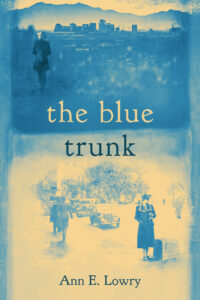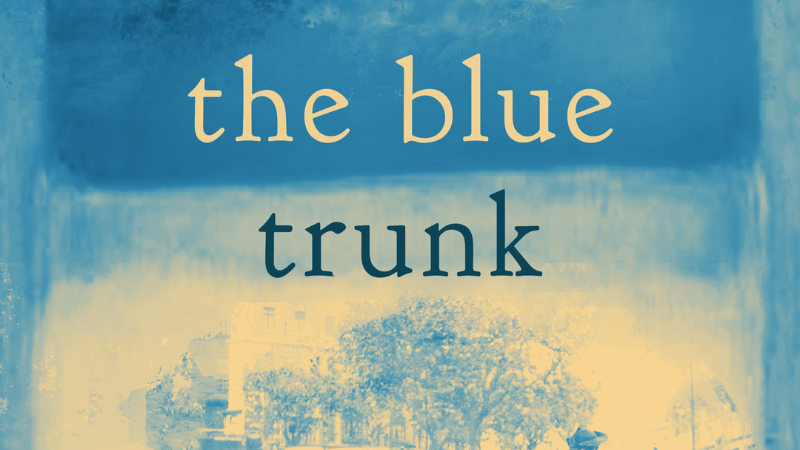When Ann Lowry inherited an ancestor’s blue travel trunk, she had no idea that this artifact was about to take her on a three-year journey of discovery. She was told that the trunk’s previous owner, a great-great aunt,  had been institutionalized for insanity. Despite meticulous genealogy research, she was unable to uncover any facts about her and concluded that she must have spent her entire adult life in an asylum. Lowry was inspired to write The Blue Trunk, (Sept. 10, 2024, Koehler Books) to help reclaim her ancestor’s voice and shed light on these all-too-common institutionalizations. Seamlessly weaving historical fiction with contemporary life, Lowry’s tale explores identity, strength, and connection across decades.
had been institutionalized for insanity. Despite meticulous genealogy research, she was unable to uncover any facts about her and concluded that she must have spent her entire adult life in an asylum. Lowry was inspired to write The Blue Trunk, (Sept. 10, 2024, Koehler Books) to help reclaim her ancestor’s voice and shed light on these all-too-common institutionalizations. Seamlessly weaving historical fiction with contemporary life, Lowry’s tale explores identity, strength, and connection across decades.
Rachel Jackson’s idyllic life takes a dramatic turn when she discovers a woman’s scarf in her politician husband’s computer bag. But in an election year, seeking answers to questions of infidelity is not an option. When her mother gives her a family heirloom, a travel trunk owned by an ancestor, she finds a distraction. As she immerses herself in its contents, she discovers a woman whose life is vastly different from her own. Or is it?
Determined to dispel the notion that her ancestor Marit was insane, Rachel sets out to unveil her unknown story. In the interwoven narratives of these two women, who are bound by blood and a shared struggle, The Blue Trunk is a poignant exploration of identity, love, and unwavering strength.
Praise for The Blue Trunk
“Ann Lowry weaves a miracle of storytelling in The Blue Trunk, seamlessly blending past and present and the complications of gender, infidelity, and family battles across Norway and America. As a young woman searches for answers to her troubled, seemingly unfixable marriage, she finds solace and strength in the story of her forebears. This decades-long tale, influenced by figures from gangsters to politicians, finds its heart in the connection between an aunt and niece who’ve never met but whose lives are tightly intertwined.”
– Randy Susan Meyers, international bestselling author of The Murderer’s Daughters and The Many Mothers of Ivy Puddingstone
“The Blue Trunk is a transformative story that weaves two women’s stories together, pulling you into a journey filled with heartfelt emotion, strength, and transformation. Lowry is an adventurous storyteller who masterfully creates depth within her characters, making us feel like we’ve known them forever. The Blue Trunk is a beautiful and seamless read you cannot put down.”
– Dianne C. Braley, author of The Silence and the Sound, winner of the NYC 2022 Big Book Award
“A gripping story of two women separated by a century, each facing battles that appear vastly different on the surface yet share strikingly similar underpinnings. Lowry delivers a gripping, emotional and beautifully written read, with characters whose journeys will resonate long after you turn the last page.”
– Rachel Stone, Author of The Blue Iris
“The Blue Trunk carries readers through time in this story of two women whose connection is discovered through a family heirloom in the form of a blue trunk. While Marit’s emigration from Norway to America and into a life laden with hardship unfolds over the course of decades, Rachel’s struggle over modern-day challenges assumes remarkable reflections to those of her late ancestor. Lowry’s protagonists are propelled into their respective relationships and lives, buoyed by the enduring strength of the Sletmo women in this engaging, well-paced novel.”
– Brenda K. Massman, author of Yet, Here We Are
The Blue Trunk
Ann E. Lowry | September 10, 2024 | Koehler Books | Historical/Contemporary Fiction
Paperback | $21.95 | 979-8-88824-439-5
Hardcover | $28.95 | 979-8-88824-441-8
More about Ann E. Lowry:
 Ann E. Lowry’s journey into the realm of storytelling was foretold by a Sedona psychic in 2001. That prophecy became a reality two decades later when Ann discovered a family heirloom, a travel trunk from Norway, which sparked the genesis of her debut novel, “The Blue Trunk.”
Ann E. Lowry’s journey into the realm of storytelling was foretold by a Sedona psychic in 2001. That prophecy became a reality two decades later when Ann discovered a family heirloom, a travel trunk from Norway, which sparked the genesis of her debut novel, “The Blue Trunk.”
A writer her entire life, Ann holds a Ph.D. in Communication from the University of Minnesota. Her career has been dedicated to teaching and helping others navigate communication and resolve conflicts. Ann is fascinated by the dynamics of relationships, discord, and the intricacies of the human condition. Ann successfully completed the Loft Literary Center’s Novel Writing Intensive course in 2022.
Alongside her passion for fiction, she has contributed to academic journals, penned thought-provoking opinion pieces, crafted engaging content for online platforms, and provided insights on the federal management of disasters.
When Ann isn’t immersed in the world of writing, she finds solace in the pool or the lake. She cherishes playful moments with her rescue-turned-therapy dog, Loki, and also enjoys reading, golfing, and indulging in the art of cookie and bread baking. Fly fishing is her newest hobby. Most of all, she savors precious time with her family.
Ann and her spouse, Karen, and fur child, Loki, live in Timnath, Colorado, where they enjoy the beauty of nature daily. Learn more about Ann at: www.annlowry.com
In an interview, Lowry can discuss:
- Writing a fictional novel inspired by true events in her family’s history
- The research she did into mental institutions in the early 1900s
- The struggles faced by female characters decades apart from each other, and how “crazy” women have been treated throughout history
- Writing about gender identity with care and accuracy
- The importance of keeping history alive, even when it is not flattering
- Completing your novel in a writing intensive course
An Interview with Ann E. Lowry
1. What was your initial reaction when you heard your ancestor Marit’s story?
I was sad and angry that my family had, essentially, taken away my great-great aunt’s personhood. While I understand that this was typical for the times, these behaviors set up family dysfunction (secrets) that can be carried on for generations.
2. What kind of research did you do to try and discover what happened to Marit, and how did that play into your writing?
I researched her on all possible genealogy sites and also worked with historical societies to find logs of individuals in state hospitals for the mentally ill. Ultimately, I discovered that institutionalized individuals often were not counted in the census and often were not issued death certificates (two ways to find information on ancestors). I found a cemetery in Eau Claire, Wisconsin that was used for the interment of asylum patients. Most of the graves on site were marked “Unknown.”
3. How do you think Rachel and Marit’s struggles are similar? How are they different?
They both want to create a life for themselves, but are faced with significant barriers to doing that. They both suffered childhood trauma with the loss of a sibling and both have unresolved grief around those losses. Even though she doesn’t realize it at first, Rachel has more agency than Marit and has the advantage of living in more progressive times. That said, Rachel is fighting contemporary political battles which threaten current day civil rights.
4. How did you craft Blake’s character?
When I first created Blake, I had planned to have him be a stereotypic cheating spouse. But as he developed, I started to really like him! At the time, I also happened to be reading Love Lives Here by Rowan Jette Knox and decided to add gender identity questions to his character. I went back and re-wrote scenes with him and ultimately he became a kind, smart, and sensitive character whose struggles are unique but similar to Rachel’s and Marit’s.
5. What made you decide to add gender fluidity to your novel? How did you make sure to approach the subject with sensitivity and accuracy?
As I mentioned, I was influenced by Rowan Jette Knox’s book but also early feminists who advocated for more gender fluidity. I am a member of the LGBTQ+ community, but I am not trans, so I wanted to be very careful with the subplot about Blake to make sure that I wasn’t co-opting someone else’s story. And honestly, this story is not mine to tell. But, it is an important story, so I took a bit of liberty and wrote this. I did research, interviewed some pertinent people, and had beta readers give input into what I wrote.
6. Why were the themes of identity and grief so important for you to explore in this novel?
Here is the part where I admit that some of this is my story. I lost my sister when I was six, and to be honest, I still deal with that loss, all these decades later. When you lose a family member, you no longer know who you are or where you fit in the family system. Grief can be, and often is, complicated, and this compounds questions of identity. In the end, Rachel has a better sense of who she is, but as she notes, her sister will always be by her side.
Download press kit and photos

A former award-winning journalist with national exposure, Marissa now oversees the day-to-day operation of the Books Forward author branding and book marketing firm, along with our indie publishing support sister company Books Fluent.
Born and bred in Louisiana, currently living in New Orleans, she has lived and developed a strong base for our company and authors in Chicago and Nashville. Her journalism work has appeared in USA Today, National Geographic and other major publications. She is now interviewed by media on best practices for book marketing.


